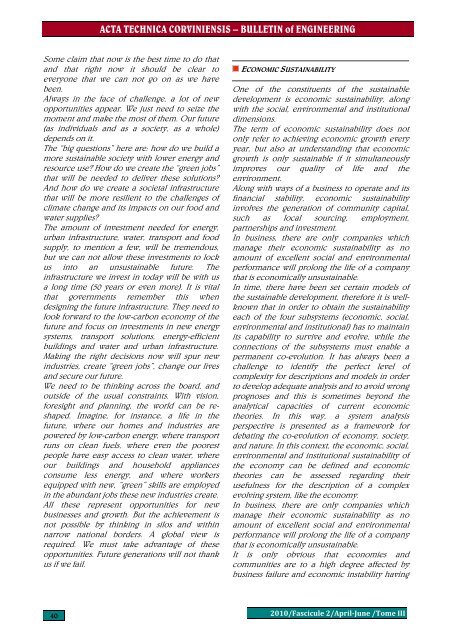ACTA TECHNICA CORVINIENSIS - Bulletin of Engineering
ACTA TECHNICA CORVINIENSIS - Bulletin of Engineering
ACTA TECHNICA CORVINIENSIS - Bulletin of Engineering
- No tags were found...
Create successful ePaper yourself
Turn your PDF publications into a flip-book with our unique Google optimized e-Paper software.
<strong>ACTA</strong> <strong>TECHNICA</strong> <strong>CORVINIENSIS</strong> – BULLETIN <strong>of</strong> ENGINEERINGSome claim that now is the best time to do thatand that right now it should be clear toeveryone that we can not go on as we havebeen.Always in the face <strong>of</strong> challenge, a lot <strong>of</strong> newopportunities appear. We just need to seize themoment and make the most <strong>of</strong> them. Our future(as individuals and as a society, as a whole)depends on it.The “big questions” here are: how do we build amore sustainable society with lower energy andresource use? How do we create the “green jobs”that will be needed to deliver these solutions?And how do we create a societal infrastructurethat will be more resilient to the challenges <strong>of</strong>climate change and its impacts on our food andwater supplies?The amount <strong>of</strong> investment needed for energy,urban infrastructure, water, transport and foodsupply, to mention a few, will be tremendous,but we can not allow these investments to lockus into an unsustainable future. Theinfrastructure we invest in today will be with usa long time (50 years or even more). It is vitalthat governments remember this whendesigning the future infrastructure. They need tolook forward to the low-carbon economy <strong>of</strong> thefuture and focus on investments in new energysystems, transport solutions, energy-efficientbuildings and water and urban infrastructure.Making the right decisions now will spur newindustries, create “green jobs”, change our livesand secure our future.We need to be thinking across the board, andoutside <strong>of</strong> the usual constraints. With vision,foresight and planning, the world can be reshaped.Imagine, for instance, a life in thefuture, where our homes and industries arepowered by low-carbon energy, where transportruns on clean fuels, where even the poorestpeople have easy access to clean water, whereour buildings and household appliancesconsume less energy, and where workersequipped with new, “green” skills are employedin the abundant jobs these new industries create.All these represent opportunities for newbusinesses and growth. But the achievement isnot possible by thinking in silos and withinnarrow national borders. A global view isrequired. We must take advantage <strong>of</strong> theseopportunities. Future generations will not thankus if we fail.ECONOMIC SUSTAINABILITYOne <strong>of</strong> the constituents <strong>of</strong> the sustainabledevelopment is economic sustainability, alongwith the social, environmental and institutionaldimensions.The term <strong>of</strong> economic sustainability does notonly refer to achieving economic growth everyyear, but also at understanding that economicgrowth is only sustainable if it simultaneouslyimproves our quality <strong>of</strong> life and theenvironment.Along with ways <strong>of</strong> a business to operate and itsfinancial stability, economic sustainabilityinvolves the generation <strong>of</strong> community capital,such as local sourcing, employment,partnerships and investment.In business, there are only companies whichmanage their economic sustainability as noamount <strong>of</strong> excellent social and environmentalperformance will prolong the life <strong>of</strong> a companythat is economically unsustainable.In time, there have been set certain models <strong>of</strong>the sustainable development, therefore it is wellknownthat in order to obtain the sustainabilityeach <strong>of</strong> the four subsystems (economic, social,environmental and institutional) has to maintainits capability to survive and evolve, while theconnections <strong>of</strong> the subsystems must enable apermanent co-evolution. It has always been achallenge to identify the perfect level <strong>of</strong>complexity for descriptions and models in orderto develop adequate analysis and to avoid wrongprognoses and this is sometimes beyond theanalytical capacities <strong>of</strong> current economictheories. In this way, a system analysisperspective is presented as a framework fordebating the co-evolution <strong>of</strong> economy, society,and nature. In this context, the economic, social,environmental and institutional sustainability <strong>of</strong>the economy can be defined and economictheories can be assessed regarding theirusefulness for the description <strong>of</strong> a complexevolving system, like the economy.In business, there are only companies whichmanage their economic sustainability as noamount <strong>of</strong> excellent social and environmentalperformance will prolong the life <strong>of</strong> a companythat is economically unsustainable.It is only obvious that economies andcommunities are to a high degree affected bybusiness failure and economic instability having402010/Fascicule 2/AprilJune /Tome III
















